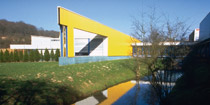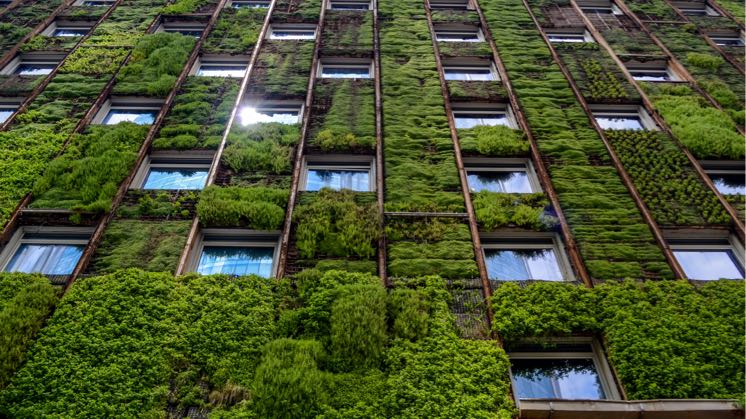Courtesy : legrandgroup.com
Green building
The notion of Green building varies depending on the specialist. For eco-builders, it means a clean building, using natural materials. They consider that a building must above all adapt to humans, the well-being of its occupants being capital. These partisans of green building condemn the use of toxic substances in the industrial manufacture of construction materials. Experts in energy savings aim to limit the negative impact of human habitat on the environment through ultra-modern technologies and to reduce the amount of energy consumed by buildings, houses and apartments. They recommend enhanced thermal insulation and leading-edge construction techniques. Eco-builders consider a building over its whole lifetime. Not only do they integrate energy savings, they also take into consideration the origin of the materials used and their management (elimination, recuperation) at the end of their life.
Eco-construction, also referred to as sustainable construction or green building, proposes various possibilities of reducing the environmental impact of buildings. Green building is not a specific construction method, but it brings together a set of techniques, materials and technologies which when suitably integrated in a construction project, contribute to enhancing its environmental performance. In an ideal world, eco-construction optimises energy efficiency, limits water consumption, makes maximum use of recycled, recyclable and non-toxic materials. It also generates as little waste as possible during the construction process and subsequent occupation.
In a green building, the structural creation processes respect the environment and make efficient use of resources. This practice is growing and complements the conventional concerns of designing buildings that are economical in energy, sustainable and comfortable. A green building is a clean, sustainable building, designed with natural materials, uses little energy and renewable ones at that, is easy to maintain and available at a reasonable cost.
A green building is designed to reduce the overall impact of the built-up environment on human health and the natural environment, through:
• The efficient use of energy, water and other resources
• Protecting occupant health and improving employee productivity
• Reducing waste, pollution and harm to the environment.
Effectively, a green building can incorporate sustainable materials (reused, recycled, recyclable, or from renewable resources) in its construction, create a healthy interior environment with a minimum of pollutants and functional landscape planning that requires less water (using indigenous greenery that thrives without additional watering).
CLEAN BUILDING

Clean building is an eco-construction or green building approach that aims to build in respect of our environment and that of future generations, while offering maximum comfort to occupants. It is also an approach that involves:
• The identification of the environmental impacts of projects throughout their lifecycle;
• The use of architectural and urban-planning techniques that prioritise natural light, integrate bio-climate principles, guarantee good thermal insulation of the whole building envelope and respect applicable legislation;
• The use of “environmental” or “natural” materials that consume little energy in their manufacture, transport and deployment;
• The promotion of the use of renewable energies and/or low-pollution fuels;
• The use of “intelligent” equipment: “Low energy” lighting and household appliances, efficient correctly-sized heating systems.
What is more, there is no clean habitat without a clean building site. To choose the right location, we must always start by considering the influences of the soil (contaminated sites, natural radioactivity, etc.) or the environment (noisome roads, industrial plants emitting toxic emissions, high voltage power lines) that may be troublesome. Installation in the route of a wind corridor, even within a large town, means the site will benefit from a pleasant atmosphere, rich in oxygen.
Green building uses resources efficiently. Its success is to leave fewer traces on the environment through the use of renewable energies and by ensuring high energy yield. This is a balanced solution between construction and a sustainable environment.
THE GREEN BUILDING
Natural construction
A natural green building construction must satisfy two additional imperatives: the adaptation of the architecture to the landscape and its measurable data, alongside the use of natural materials, which if possible are renewable. The choice of the site must be made according to natural data. In effect, topological data have a great influence on the micro-climate and therefore on the properties of a building site. So in a basin where cold air stagnates, temperatures can be 6°C below those on a flat terrain just a few hundred metres away.
Architectural forms must be inspired by nature, with colours that do not seem artificial. Natural building techniques use the materials that nature provides. When these materials replace polluting synthetic products which consume a large quantity of energy in their manufacture, their use is highly recommended. The term “natural materials” essentially covers local (renewable) raw materials that can be used according to traditional craft methods or modern techniques.
Passive building
The expression “passive building” refers to a construction standard that can be achieved using various types of construction materials. It can also mean a green building construction that guarantees an interior climate as comfortable in summer as it is in winter without a conventional heating system. Taken from the German word “Passivhaus,” this expression concerns both collective and individual habitats. The purpose of the passivhaus is to reduce energy consumption in residential buildings by capturing a passive solar energy contribution, reinforcing building insulation, using renewable energies and recuperating heat.
A passive building consumes no more than 15 kWh/m2/year for its heating and no more than 30 kWh/m2/year for heating, hot water and ventilation. Total consumption (including household appliances) must not exceed 120 kWh/m2/year in primary energy (that which is taken from nature before transformation). The passive building mark includes many specific and technical elements concerning windows, insulation and facade seals, air renewal, etc. Rigorous testing is carried out to obtain the passive building mark.
Individual passive houses are often compact. This is one condition for achieving low energy consumption. To build a passive building, the following requirements must be satisfied:
• Excellent insulation all over the building, exterior insulation from 25 to 35 cm;
• High quality triple-glazed windows;
• Building orientation to capture passive solar energy and large south-facing picture windows;
• A dual-flow mechanical ventilation system with a heat recuperation rate of at least 75%.
• Solar thermal units for hot water requirements.





